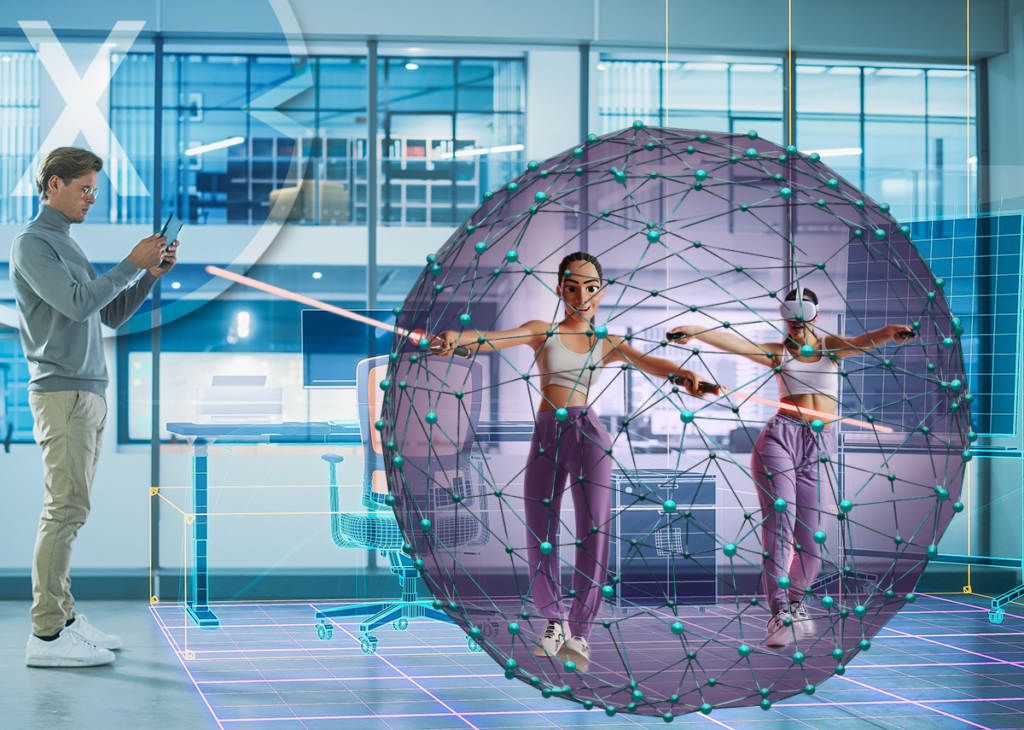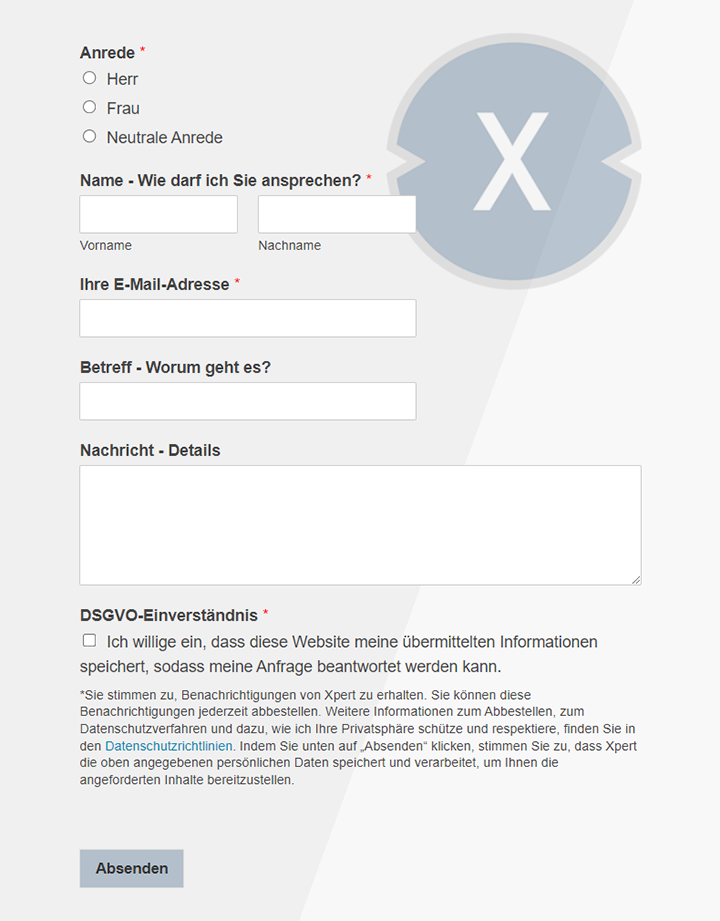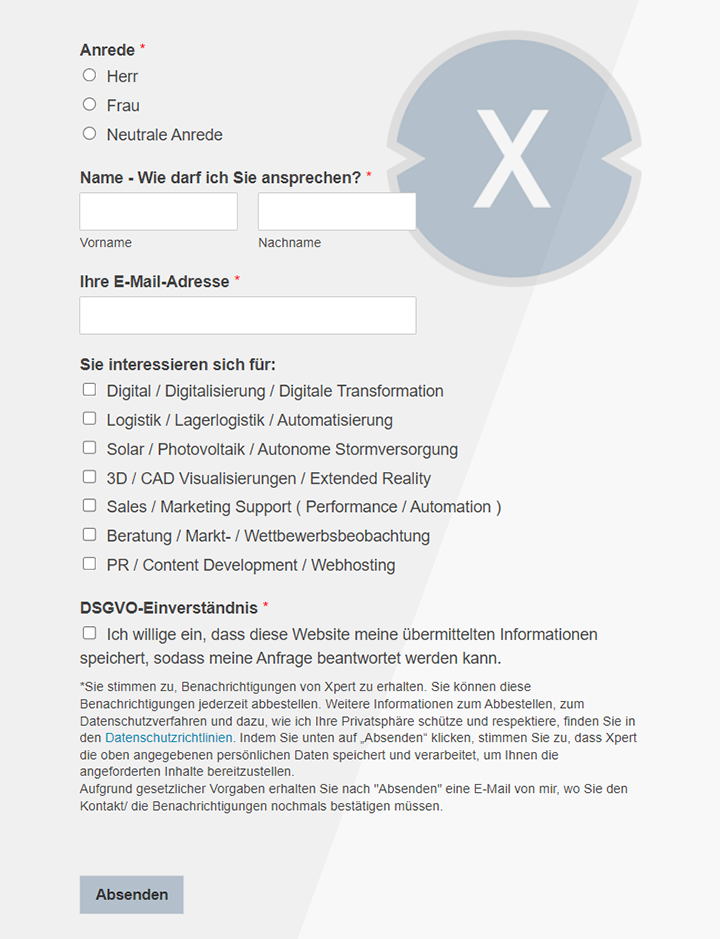Smart Glasses: The future is carried on the nose, for everyday life, sport and outdoor as well as industrial applications
Xpert pre-release
Language selection 📢
Published on: July 22, 2025 / update from: July 22, 2025 – Author: Konrad Wolfenstein
Your private 300-inch cinema display for on the go: these AI-AR glasses translated live in front of your eyes
What are smart glasses and why are you experiencing such an enormous upswing?
Smart Glasses, also known as intelligent glasses or AR glasses, represent one of the most fascinating developments in modern technology. These devices combine the familiar form of glasses with a highly developed technology and thus create a seamless connection between the physical and digital world. The current renaissance of this technology is driven by several factors: significant progress in artificial intelligence (AI), the successful market launch of products such as the Ray-Ban Meta Smart Glasses and a growing understanding of the practical applications.
The global market for smart glasses is currently experiencing a remarkable phase of growth. After an initial phase of disillusionment, which followed exaggerated expectations, the market now again records impressive growth rates. Estimates for the annual growth rate (CAGR) range from around 27% to over 60% for the coming years, which suggests considerable market potential. This development attracts a large number of new competitors, which leads to an intensification of the competition, which is described as a “struggle of hundreds of smart glasses”.
The basics of intelligent glasses are based on a combination of hardware, software and sensors. Modern smart glasses are equipped with sensors, displays, microphones and wireless compounds that enable augmented reality (AR). You can display information directly in the field of vision or be controlled by voice commands and gestures. These portable devices are used in different areas, including navigation, communication, fitness, health monitoring and industrial applications.
Suitable for:
- Xpert study on “The Market for Smart Glasses” – Analysis of market penetration, competition and future trends
How do smart glasses work technically and which core components are crucial?
The functionality of smart glasses is based on several key technologies that work seamlessly together. The display technology forms the heart of these devices. Modern Smart Glasses use specialized display technologies such as heads-up displays (HUD), in which a transparent screen projects information directly in front of the eyes without blocking the view. The wave conductor technology leads light via special wave conductor into the glass and thus creates a virtual picture.
The camera represents another central element. In Smart Glasses integrated cameras record pictures and videos and enable an analysis of the environment. These are used to create content, environmental detection in AR applications and even for facial recognition. In modern models such as the Xiaomi Ai Glasses, a 12-megapixel camera with Sony sensor is used, which can absorb 2K videos at 30 FPS.
A comprehensive sensor system monitors and analyzes movements, positions and the environment. Gyroscopes perceive movements while GPS modules provide navigation functions. These sensors work together to provide context -related information and enable interaction with the expanded reality.
What different areas of application are there for smart glasses?
The market for smart glasses is increasingly differentiated into several main segments. On the one hand, there are consumer-oriented AI glasses that rely on style, basic assistance functions and media integration, led by META. On the other hand, there are more technologically demanding augmented reality (AR) and Extended Reality (XR) devices that aim for immersive experiences, productivity and specialized corporate applications, with actors such as Apple, Microsoft, Vuzix and XReal.
The areas of application extend from simple entertainment to highly specialized industrial operations. In the entertainment, smart glasses act as portable cinemas with large virtual displays. In everyday life, they support navigation, translation and the display of notifications. In the sports and outdoor area, they enable performance tracking and safe navigation. In industrial applications, they revolutionize maintenance processes and training.
Entertainment and media consumption: The portable cinema of the future
How do Smart Glasses transform the way we consume media?
Smart Glasses as a portable entertainment platform revolutionize the way we consume media. These devices act as personal cinemas that can offer an immersive media experience anywhere and at any time. The glasses act as a portable monitor, with the video content not only at home, but also when traveling on the train, bus or plane.
The technology makes it possible to create an experience as if you were sitting in a cinema, regardless of the actual location. With high -quality displays and integrated speakers, these devices create a private entertainment zone that is shielded from the outside world. Modern models can simulate virtual screens of 200 inches or more, which corresponds to a cinema experience.
The versatility of these devices is shown in their compatibility with various media sources. They can be connected to smartphones, tablets, laptops or game consoles. This makes them a universal solution for film enthusiasts and gamers who appreciate privacy and comfort. The unique brightness adjustment enables films and games to be fully enjoyed, regardless of the ambient conditions.
What makes the Viture Luma Pro and Rokid AR Spatial entertainment champions?
The Viture Luma Pro XR Glasses represent significant progress in AR glasses technology. They offer a fully private 152-inch, 52 ° FOV, 4K-like 1200p virtual canvas with a dazzling brightness of 1000 nits. The combination of the latest Sony displays with state-of-the-art Harman audio technology creates an impressively immersive experience, which is 50% sharper and offers fuller sound than the Viture Pro.
A special feature of the Luma Pro is the micro-Oled display technology, which is described as “adorable”. The image quality is impressively spicy with lively colors, packed in a seriously elegant glasses. The electrochromic film lenses make it possible to control transparency and thus switch between immersive and a semi-transparent experience.
The Rokid AR Spatial Glasses offer a different but also impressive concept. The Rokid Max 2 AR glasses system in combination with the station 2-hub creates a massive 300-inch virtual canvas that hovers in the field of vision. These glasses are very light with only 75 grams and made of materials compatible with aerospace, which makes it suitable for longer use.
The rokid system is characterized by its crystal clear, colorful displays that reproduce liquid movements. The integrated speakers are surprisingly good and offer clear, loud sound with strong clarity, so that no headphones are required. The system runs on Rokid's own Yodaos Master and enables spatial computing with the opportunity to manage several virtual windows and switch between apps.
Suitable for:
How do virtual displays make immersive media experts?
Virtual displays in smart glasses create immersive media experts through highly developed projection technologies. The SI OLED technology of manufacturers such as Epson ensures excellent color rendering and a sharp, bright visual experience. The Full HD 1080p display optimizes all details, and the large display area corresponds to the view of a 120-inch screen from a distance of five meters.
The immersion is reinforced by several factors. On the one hand, the heads-up display enables access to content and apps on a number of devices while the hands remain free. The ergonomic headset design offers improved weight distribution, flexible brackets and optional nose pads for high wearing comfort, even with longer use.
Modern AR glasses such as the Rokid also support spatial videos and 3D content. Users can view full scale panoramas, spatial videos and photos, which leads to really interesting spatial and 3D effects. The glasses can display their own content and thus offer personalized immersive experiences.
What role do gaming and interactive entertainment play in AR glasses?
Gaming and interactive entertainment are an important area of application for smart glasses. The devices enable AAA games to play everywhere and at any time by being connected directly to handheld consoles such as Steam Deck and ROG Ally. This brings favorite games back to the large screen, even on the go.
The virtual displays with resolutions up to 173 inches and 1200p as well as fast 120Hz refresh rates create optimal gaming conditions. The electrochromic lenses and options for individual visual immersion make it possible to adapt the gaming environment to personal preferences.
Gaming is particularly interesting through spatial computing. The Rokid AR Spatial System enables spatial games in which users can interact with virtual objects in a three -dimensional space. This opens up completely new game concepts that go beyond traditional screen-based gaming experiences.
The glasses also support co-op gaming, which enables social interactions in virtual rooms. With the possibility of managing multiple windows and apps at the same time, gamers can switch between different applications without interrupting the immersive experience.
Everyday life and practical applications: the digital expansion of reality
How do Smart Glasses revolutionize navigation and location?
Smart Glasses revolutionize navigation by directing the directions in the field of vision. The AR navigation projects navigation instructions directly into the user's field of vision, so that it can move freely and has the hands free. Systems such as the Lyra AR glasses combine GPS accuracy, real-time maps and context-related information about an intuitive, easily understandable navigation experience.
This technology offers significant advantages over traditional navigation methods. Users no longer have to look at smartphone displays or carry out complicated handling with apps. The glasses recognize the location and displays the path directly in the field of vision – a revolutionary improvement for pedestrians, cyclists and even drivers.
With the help of GPS, smart glasses can provide precise navigation instructions so that users achieve their goals safely and efficiently. The glasses also remember the places visited beforehand and can display the way there if necessary. This “memory function for places” makes navigation more personal and efficient because the glasses display the way directly into the field of vision.
Navigation in urban environments is particularly valuable. Users in foreign cities can receive information about sights in real time that are shown directly via the real objects. This creates a new form of urban experience, in which digital information seamlessly merge with the physical environment.
How do smart glasses overcome language barriers through real-time translation?
Real-time translation is one of the most revolutionary functions of modern smart glasses. The Google AR glasses, for example, recognize spoken languages and immediately indicate the translation in the field of vision. For travelers, business people and even in the field of education, this could be revolutionary, since language barriers are minimized and communication is simplified worldwide.
The Lyra AR glasses offers both immediate text-to-text and language-to-text translation. Users simply look at the text to be translated, and the translation is displayed directly in their field of vision. In addition, the glasses can convert language into text so that conversations can be easily followed. This opens up a world of unlimited intercultural communication.
The Xiaomi Ai Glasses expand this functionality even further and offer live translation in ten languages, including English, Japanese, German and Spanish. This even exceeds the Ray-Ban Meta glasses, which currently only offer translations in English, Spanish, Italian and French.
A practical application scenario illustrates the benefits: a traveler in a foreign country can have a conversation without pulling the cell phone out of your pocket and seeing the translation directly. This progress not only has practical effects, but also enormous potential to reduce cultural and linguistic barriers.
Suitable for:
- Adieu smartphone? The AR Smart Glasses Innovation Invasion is here: real-time translation and context-related information
What role do AI assistants and context-based information play?
AI assistant in Smart Glasses offer context-based information that significantly improve the user experience. For example, the Meta Ai in Ray-Ban glasses can answer questions about what the user sees through the glasses. This contextual perception enables the AI to provide relevant information about the environment without the user having to explicitly ask about certain details.
The integrated AICY assistant in the Myvu/Imiki Ar Glasses can be activated by long pressing on the right bracket or via voice command. It offers access to various everyday helpers and can provide context -related support. The glasses with over 200 patents enable the AI assistant to understand complex inquiries and provide appropriate answers.
The Xiaomi Ai Glasses demonstrate the variety of AI functions with object recognition, text translation, transcription, intelligent summaries and even calorie count. You can also act as a “meeting assistant”, answer everyday questions and offer live translations.
The Apple Smart Glasses, which are expected for 2026, are intended to offer Apple Intelligence a deep AI integration. The glasses are intended to recognize context -based information and to be able to show the user information – such as opening times or reviews of shops. These intelligent notifications are filtered by AI so that only important information reaches the user.
How do notifications and communication work in the field of vision?
Smart Glasses transform notifications and communication through direct integration into the field of vision. The Even Realities AR-Glasses enables messages to read, without interruption – simply by briefly lifting the head. This inconspicuous type of information transmission revolutionizes the way we interact with digital news.
The intelligent filtering of notifications is made possible by AI. Not every notification should interrupt the user – the AR glasses recognize with AI when the user has time and files unimportant information. Important messages, such as a meeting or a message from contact from the favorite list, appear in the field of vision. This unobtrusive but helpful notification strategy significantly improves productivity.
The communication functions go beyond simple notifications. Smart Glasses make it possible to accept calls and send text messages via voice commands. The open ear speakers, which are integrated into the glasses frames, enable music to listen or to accept calls without additional headphones being needed.
For example, the Ray-Ban Meta glasses support seamless calls and can send text and voice messages via WhatsApp and other apps by voice command. This free -handed communication is particularly valuable in situations in which hands are needed for other tasks or if the smartphone is not accessible.
🗒️ Xpert.Digital: A pioneer in the field of extended and augmented reality
🗒️ Find the right meta -verse agency and planning office like consulting firm – search and wanted top ten tips for advice & planning
More about it here:
First-person technology at the limit: Smart Glasses as a personal high-tech coach
Sports and outdoor: performance enhancement through intelligent technology
How do Meta and Oakley revolutionize the sports area with Smart Glasses?
The partnership between Meta and Oakley marks a turning point in the development of Smart Glasses for the sports area. The Oakley Meta HSTN glasses, which were presented in June 2025, represent a new category of performance AI glasses that combine Oakley's characteristic design with METAS leading technology.
These glasses have been specially developed for athletes and fans and offer significant improvements compared to the existing Ray-Ban META models. The Oakley Meta HSTN can record actions with the integrated camera and share the unique perspective of the user. With powerful open ear speakers, which are seamlessly integrated into the frames, users can hear their favorite music or consume podcasts.
The glasses have an IPX4 water strength, which means that users can go to their outermost performance limits. This robustness makes you ideal for various outdoor activities and competition situations. The Meta Ai integration enables athletes to get more out of their Oakley Meta HSTN glasses immediately after unpacking.
The technical improvements are impressive: the Oakley HStN glasses offer double battery life with up to 8 hours of typical use and up to 19 hours in standby mode. The camera was upgraded to Ultra HD (3K) video, which represents a significant improvement compared to the 1080p recording of the Ray-Ban meta-glasses.
Suitable for:
- Oakley Meta HStn Smart Glasses with the personal AI assistant Meta AI: The new generation of intelligent sports glasses
What is the importance of performance tracking and biometric data?
Performance tracking through smart glasses revolutionizes the way athletes monitor and improve their performance. The Engo Smart Glasses for endurance athletes offer immediate, smooth, free -handed access to power metrics with a long battery life. These glasses show essential key figures such as cadence, time, performance and height profit in real time, while the athlete remains completely focused on its activity.
The intelligent connectivity enables low-energy bluetooth connections to smartphones and smartwatches from Apple Watch, Garmin and Suunto for optimal networked experience. This integration creates a comprehensive ecosystem for performance monitoring that combines all relevant data in a heads-up display.
Solos Smart Glasses demonstrate the variety of available biometric data acquisition. They follow steps, removed removal, burned calories, active minutes, sleep and heart rate. They even appreciate the maximum oxygen absorption, which is a measure of the maximum amount of oxygen that the body can use during intensive exercises.
Real-time monitoring enables athletes to maximize their efforts without distractions. By projection of the data directly into the visual field, athletes can continuously monitor their performance without having to take a look from the activity. This is particularly important for high-speed activities such as cycling or triathlon competitions.
How do smart glasses support and security support outdoor activities?
Smart Glasses offer significant safety advantages for outdoor activities through the integration of navigation aids and security features directly into the field of vision. The main advantage is that performance data is always displayed in the field of vision, similar to the head-up display in a car. As a result, athletes cannot avert attention if they check their current performance data.
This continuous visibility of the data ensures more security on the street. Athletes have fewer head movements, which is particularly important when they drive at high speeds, for example in triathlons or time trials. Every movement of the head and helmet away from the optimal aerodynamic position causes additional air resistance.
The Oakley Meta HSTN glasses with their IPX4 water resistance are specially developed for demanding outdoor conditions. You can cope with sweat, rain and splash water, which makes you perfect for outdoor training in changing weather conditions. The reinforced audio system also works well in the wind and background noise of outdoor activities.
The improved battery life of 8 hours means that athletes can use these glasses for long training sessions, multi -day adventure or entire competition days without constantly worrying about the battery life. This reliability is crucial for security with longer outdoor activities.
What role do training and coaching play through intelligent glasses?
Intelligent glasses are increasingly acting as a personal trainer and coaching assistant. The Solos Smart Glasses with Airgo serve as personal trainers who lead users through training routines, pursue progress and motivate fitness goals. They act as an intelligent fitness companion who pursue activities, monitor heart rate and record training data.
Coaching takes place in real time by integrating audio coaching and direct feedback. These functions support improved performance and reduce the risk of injury. The glasses are light, weatherproof and designed to adapt to different lighting conditions, which offers an incomparable training experience.
The Meta Ai in the Oakley glasses can help athletes get more out of every moment. With 'Hey Meta' or simple tapping, users receive answers during training, can check tides on the go or discover local hiking trails – everything is freehand. From preparation to achieving the goals, Meta Ai helps maximize every aspect of the game.
The versatility of the training is expanded by the possibility to create custom training and to view the training story. The glasses can follow up to 15 clear users from whom each of whom can have their own settings, goals, profiles and training plans. The app is also compatible with third-party fitness apps, which enables integration into existing training routines.
Industrial applications: The digital revolution of the world of work
How do data glasses transform industry and logistics?
Data glasses revolutionize industry and logistics by providing real -time information and free -handed work processes. In logistics, pick-by-vision solutions enable fully digitized material flow control. At Klosterfrau Berlin, for example, Picavi's data glasses have become an elementary work equipment for production supply since 2016.
The advantages are measurable: workers have their hands free and can concentrate on their actual logistical task, pecking. You are visually guided through your order using the clearly structured interface on the display. As a result, the error rate drops significantly, almost zero, and the picking tasks are carried out faster. When picking small parts, time savings of up to 30% can be achieved by data glasses compared to the previous solution.
Proglove has established itself as a leading provider of ergonomic wearables for industry. The Mark Display, a glove scanner with an integrated screen, enables employees in industrial and logistics contexts to receive relevant information on the mobile and reduce the error rate during the scanning process. With haptic feedback and acoustic signals, the application leads employees through the picking process and enables scanning processes in which up to six seconds can be saved.
Digitization is continuously progressing in logistics. The more digital the warehouse becomes, the more possible uses for smart glasses. The data obtained with the glasses can be used in a targeted manner for previous processes in order to identify and implement continuous improvements.
Suitable for:
- Do Industrial Smart Glasses soon replace our smartphones? Transformation on the horizon – also in industry – are the AI glasses now come?
How does Proglove design the future of workers' support?
Proglove positions himself as a pioneer in connecting workers to the industrial Internet of Things (IIOT). The company's vision is to connect the worker to the Internet of Things and offer a comprehensive range of wearables and software products. The company has developed a great product fit for its Mark family, with different areas of application in various industries such as automotive, logistics and retail.
The latest ProGlove Mai is a smart, portable assistant that provides data -based insights for safe, healthier and optimized operating processes in real time. It enables highly efficient processes in industry and logistics through human-technology symbiosis. The employees have intelligent technology that provides process insights in real time and enables free -handed work processes for optimized workflows.
The ergonomic design of the ProGlove Mai enables maximum comfort. The glove compatible interaction with four keys and a touch display makes working easier and contributes significantly to the satisfaction of the employees. With a weight of only 65g and 21 mm, the device is slightly on the back of the hand and withstands the most demanding work environments.
The Proglove Cloud solution is an employee-centered application for industrial process analyzes. The data recorded is placed in a context in real time and can be transferred to the Mark Display. In this way, bottlenecks are identified in order to optimize employee use or to provide security instructions for increasing occupational safety in the event of unforeseen lace loads.
What role does maintenance and remote assistance play with AR technology?
AR-supported remote maintenance enables service staff from plant and mechanical engineers, maintenance, repairs or even commissioning remotely to be carried out. A specialist is switched on and can follow the maintenance work through a combination of mixed and virtual reality. Such a system consists, for example, the augmented reality glasses Hololens and the Holodesk remote platform.
In practice, this works as follows: If an employee needs help on site at a machine, he puts on the AR glasses, opens the app and describes his problem with the contact person who is switched on live. The real -time data of the glasses can take the field of vision and the perspective of the employee on site. The employee has his hands free to work on the machine.
The technician can mark elements of the machine on his screen, which the local employee can see directly on the objects on the object. In addition, access to documents, checklists and manuals is possible, which can be displayed by data glasses. The employees receive instructions for troubleshooting, at the same time the technician can check whether they have been implemented correctly.
Microsoft Hololens has established itself as a leading platform for industrial AR applications. For example, Schwan Cosmetics uses an AR solution with Microsoft Hololens from T-Systems to maintain its production machines. Service experts from the Schwan headquarters are connected to the user of the machine on site via a desktop app and can transfer instructions directly into the field of vision.
How does the University Hospital Würzburg demonstrate innovations in healthcare?
The University Hospital Würzburg (VHF) demonstrates innovative applications of AR glasses in healthcare through a pioneering study on anesthesia monitoring by data glasses. In the event of interventions in the six operating theaters used by urology and trauma surgery, at least one anesthesist is responsible for every anesthesiological treatment in the operating room.
The problem that is solved by AR glasses is the following: Since supervisors cannot be at the same time in all surgical halls, the patient's vital parameters are transferred to an inpatient center. However, as soon as a supervisor goes to an operating room, she or he is only connected to the other halls by phone – the vital parameters there are no longer in mind, but they are dependent on oral information.
The solution was developed in cooperation with the Chair of Psychological Ergonomics at the Institute for Human-Computer Media at the University of Würzburg. Together they developed an application that enables the supervisors to show the information from several halls via head-mounted display (HMD). The HMD is an augmented reality glasses that project the data and, if necessary, alarms virtually in front of the eyes without visually shielding the carriers from the outside world.
The design of Smart Glasses is particularly crucial for patient interaction in the healthcare system. A study by the Leibniz Institute for Labor Research at the TU Dortmund with over 400 participants shows that the design of the smart glasses is crucial for interaction work. People who wear glasses with familiar design are assessed as competent and trustworthy as people without glasses.
Camera focus: the visual revolution of the smart glasses
Why are the Xiaomi Smart Glasses with their camera at the center of attention?
With their innovative camera focus, the Xiaomi Ai Glasses have positioned themselves as an important competitor to established smart glass manufacturers. Xiaomi indicated early on that the camera would serve as the central feature of its smart glasses, which was confirmed in the final implementation. The glasses are equipped with a 12-megapixel Ultra wide-angle camera, which is based on Sony's IMX681 sensor.
The technical specifications are impressive: the camera can record detailed 2K videos with 30 FPS and create stills with a resolution of 4,032 × 3,024 pixels. This first person perspective makes you ideal for immersive content creation or real-time visual documentation. The camera offers an ƒ/2.2 aperture with a 105 ° angle, which enables a wide range of recording.
What particularly distinguishes the Xiaomi glasses is the integration of electronic image stabilization (ice). This function is crucial for the recording of stable videos, even when the wearer is moved. The glasses support both photo and video recording and can trigger them via voice commands or by touching the frame.
A unique feature is the planned Alipay QR code function. Users can simply look at an Alipay QR code and pay for goods and services with a voice command. This function is to be available as an OTA update in September 2025 and shows the potential for context-based, camera-controlled interactions.
How do smart glasses photography and video perspective revolutionize from an first person perspective?
Smart Glasses revolutionize photography and video through the possibility of creating recordings from the carrier's exact perspective. The Ray-Ban Meta Smart Glasses were pioneers in this area with two 5 megapixel cameras that can take videos and photos. To trigger a recording, users can either press a release button on the glasses frame or use a voice command.
The first person perspective offers completely new opportunities for visual documentation. Users can capture spontaneous moments if the hands are not free or if they want to capture a moment quickly. The Oakley Meta HSTN glasses have further developed this technology and now offer 3K video recordings, which represents a significant improvement compared to the 1080p recording of previous models.
The Xiaomi Ai Glasses demonstrate the variety of recording options. In addition to standard photography and video, you also support live streaming and video calls from the first person perspective. The glasses are also optimized for live streaming, whereby users can switch directly to the glasses perspective, which is particularly useful for outdoor streaming.
The recording quality has improved considerably. Tests show that modern smart glass cameras can keep up with smartphones. The photo quality of the meta-glasses can, for example, compete with an iPhone 12 and is completely sufficient for Instagram and other social media. The videos are slightly warmer in the sound as smartphone recordings, but offer a unique perspective that is not possible with conventional cameras.
What is the importance of content creation and social media for smart glasses?
Content Creation and social media represent one of the main drivers for the adoption of Smart Glasses. The Ray-Ban Meta Smart Glasses are designed to interact seamlessly with Instagram and Facebook, including the possibility of live streaming on these platforms. This direct integration makes you powerful tools for content manufacturers who want to share your experiences in real time.
The glasses enable a completely new type of content creation through the hands-free operation. Creator can record videos while performing other activities, which leads to more authentic and more immersive content. The LED display provides others about when it is recorded, which takes important privacy aspects into account.
The technical improvements of recent generations significantly expand the content-creation options. The Oakley Meta HSTN glasses with 3K recording offer professional quality for content creation. The extended battery life of 8 hours enables creatorn to carry out longer sessions without interruption.
Live streaming skills have become particularly valuable. The Xiaomi glasses, for example, support real-time live streaming and video telephony from the first person perspective. Creator can share your surroundings and activities in real time, which leads to more committed and more authentic content. The possibility of switching directly to the glasses perspective directly in the live streaming app makes this functionality particularly user-friendly.
What is the future of visual documentation with Smart Glasses?
The future of visual documentation with Smart Glasses is shaped by several technological trends. The continuous improvement of camera quality – from 1080p to 3K and beyond – makes smart glasses to serious alternatives to conventional cameras. The integration of AI-based features such as automatic image stabilization and intelligent scene recognition will further improve the recording quality.
An important trend is the integration of AI assistants that can analyze visual content in real time. The Xiaomi glasses can already recognize objects and count calories, which shows how AI can expand the visual documentation. Future developments could include automatic tagging of content, intelligent processing and context-based metadata generation.
Development towards longer battery life – such as the 8-hour term of the Oakley glasses – enables continuous documentation over longer periods. This is particularly important for professional applications such as documentary film production, journalism or scientific research, where interruption -free recording is critical.
Samsung works with the “Project Haean” on AR glasses with an integrated display that can project information directly into the field of vision. This development indicates a future in which visual documentation is combined with augmented reality features, so that content recorded can be enriched immediately with contextual information. The integration of several cameras and sensors will make it possible to create more complex visual narrations that capture both the environment and the reactions of the carrier.
🎯🎯🎯 Benefit from Xpert.Digital's extensive, fivefold expertise in a comprehensive service package | R&D, XR, PR & SEM

AI & XR-3D-Rendering Machine: five times expertise from Xpert.digital in a comprehensive service package, R&D XR, Pr & SEM – Image: Xpert.digital
Xpert.Digital has in-depth knowledge of various industries. This allows us to develop tailor-made strategies that are tailored precisely to the requirements and challenges of your specific market segment. By continually analyzing market trends and following industry developments, we can act with foresight and offer innovative solutions. Through the combination of experience and knowledge, we generate added value and give our customers a decisive competitive advantage.
More about it here:
Future of seeing: How Smart Glasses expand our reality and change digital perception
Technical developments: The Hardware Revolution of the Smart Glasses
How do display technologies and image quality develop?
The display technologies in Smart Glasses have made dramatic progress in recent years. The latest generation uses micro-oled technology that delivers extraordinary image quality. The Viture Luma Pro, for example, has Sony displays, which offer a 4K-like 1200p resolution with 1000 nits brightness. This technology is described as “adorable” and offers impressively sharp details with living colors.
The Rokid AR Spatial Glasses set new standards with their 1200p resolution per eye, a 120Hz refresh rate and an impressively wide 50-degree field of view. These specifications exceed the 46-47 degrees of the competition and thus offer a more comprehensive visual experience. The micro-oled technology ensures excellent color rendering and a sharp, bright visual experience.
A significant progress is the development of Electrochromic films that enable dynamic adjustment of transparency. This technology allows users to switch between a completely immersive experience and a semi-transparent view, depending on the application context and the surrounding area. The Viture Luma Pro can change the tint in just 0.2 seconds.
Epson's SI OLED technology shows how display technologies specialize. It ensures excellent color rendering and a sharp, bright visual experience, whereby the large display area corresponds to the view of a 120-inch screen from a distance of five meters. This technology optimizes all details and creates an almost perfect image quality for professional applications.
Suitable for:
- Advancement in XR technology for the Metaverse, AR and VR glasses: full-color laser for 4K smartglasses from TDK
What progress is there for battery life and hardware optimization?
For a long time, the battery life was one of the biggest challenges for smart glasses, but the latest developments show significant improvements. The Oakley Meta HSTN glasses represent a breakthrough with up to 8 hours of use – twice as much as the Ray-Ban meta-glasses with 4 hours. In standby mode, the Oakley glasses can last up to 19 hours.
The charging speed has also improved considerably. The Oakley HSTN glasses can be charged to 50% in just 20 minutes, and in 45 minutes you can reach 85% load. The charging duis offer an additional 40-48 hours of running time, which significantly expands practical use.
Xiaomi also demonstrates impressive battery optimizations with its AI Glasses. The 263mAh silicon carbon battery enables 8.6 hours of use, including various activities such as 15 one-minute video recordings, 50 photos, 90 minutes Bluetooth calls or 20 minutes Xiaoai language conversations. In standby mode you can hold up to 21 hours.
Hardware optimization goes beyond the pure battery life. The second generation of sports smart glasses has become easier, with weights around 36 grams, which corresponds to the weight of normal sunglasses. The Engo Smart Glasses offer 12 hours of battery life with an intelligent system for energy management. This combination of a long term and reduced weight makes smart glasses more practical for everyday use.
How does connectivity and ecosystem integration develop?
The connectivity of Smart Glasses has developed into a comprehensive ecosystem that enables seamless integration with various devices and platforms. Proglove demonstrates this development with its plug-and-play solution, which adapts seamlessly to every operating system. With just a few simple steps, Proglove effortlessly integrates into existing work environments from day one.
Bluetooth connectivity has improved considerably. The Oakley Meta HSTN glasses use Bluetooth 5.3, while the Ray-Ban Meta-glasses use Bluetooth 5.2. These newer standards enable more stable compounds with lower energy consumption. The Xiaomi Ai Glasses use a dual chip approach with the Snapdragon AR1 processor and an additional energy-saving chip that operates Xiaomis Vela OS operating system.
Integration into existing ECOSYSTATION is becoming increasingly important. Samsung develops its AR glasses based on Android XR, which promises complete compatibility with Google services and Android apps. This platform integration enables users to seamlessly transfer their existing digital habits to Smart Glasses.
Multi-platform support becomes standard. The viture glasses support SpaceWalker on iOS, Android, MacOS and Windows. This comprehensive compatibility enables users to use their glasses with different devices without having to commit to a certain ecosystem. The integration of cloud services, as Demonstrates Proglove with its ProGlove Cloud, enables extended data analysis and management across device boundaries.
What are the challenges of data protection and privacy?
Data protection and privacy represent critical challenges for smart glasses, especially because of their camera functions. Meta has confirmed that image and video data are used for training the META AI, but only if users actually use the META AI. This data usage raises concerns about data protection practices.
The processing of image data in the cloud is an important problem. Most Smart Glasses do not have enough local computing power, so that image data must be sent to the cloud server for evaluating. This enables spectacular features, but the information sent in the cloud is not only evaluated, but also used for the training of AI models and are stored in any form.
The visibility of the recording is an important aspect. The Ray-Ban Meta glasses have a white LED on the front, which illuminates when it is absorbed to inform outsiders. If this LED is hidden, the system warns the user. These transparency features are crucial for the social acceptance of technology.
The legal framework still develops. In certain sectors such as the healthcare system there are additional legal requirements for the use of smart glasses. The development of uniform data protection standards and regulations will be crucial for the broad adoption of this technology. Unnoticed recordings, language records and the potential susceptibility to cyber attacks raise ethical and safety -related questions that must be addressed jointly by manufacturers, legislators and users.
Future perspectives: The next decade of the Smart Glasses
How does the market develop and what growth forecasts are there?
The market for smart glasses shows exceptionally strong growth indicators. Counterpoint Research estimates that the worldwide sales of Smart Glasses will increase significantly, from less than 3 million pieces in 2024 to significantly higher numbers in the coming years. The annual growth rates (CAGR) vary between 14.5% (Technavio, 2024-2029) and 29.4% (market sand markets, 2024-2030).
The most successful products already show impressive sales figures. Meta-CEO Mark Zuckerberg reported that the sales of the Ray-Ban Meta Smart Glasses tripled last year. Essilorluxottica CEO Francesco Milleri called the number of 2 million Ray-Ban Meta-glasses sold in February since the market launch in October 2023.
The market is increasingly differentiated into different segments. On the one hand, consumer-oriented AI glasses that rely on style and basic assistance functions, on the other hand more technologically demanding AR and XR devices for immersive experiences and specialized applications. This diversification creates space for different players and price segments.
The market dynamics are shaped by the intensification of the competition, which is described as a “struggle of hundreds of smart glasses”. This development attracts a large number of new competitors and leads to accelerated innovation and improved cost efficiency through scale effects.
Which new players and innovative approaches shape the industry?
The Smart Glasses industry is experiencing an influx of new players with innovative approaches. Samsung positions himself as a significant competitor with his “Project Haean”, which is scheduled to come onto the market in 2025. In contrast to Metas Ray-Ban models, the Samsung glasses should have integrated displays that can project information directly into the field of vision.
With its AI Glasses, Xiaomi has developed a direct answer to the Ray Ban Meta glasses. The glasses offer competitive features such as a 12MP camera, five microphones with wind noise reduction and up to 8.6 hours of battery life. The planned Alipay QR code function, which enables context-based payments, is particularly innovative.
Specialized providers such as Viture and Rokid focus on high-quality display technologies and entertainment applications. Viture relies on micro-oled technology with 4K-like clarity, while Rokid has developed an independent operating system for spatial computing with his Yodaos Master.
With its G1 glasses, even realities presents a AI-focused approach that integrates chatt-like functionality directly into the glasses. These glasses aim at practical everyday applications such as navigation, translation and voice control and show how AI assistants can define the core functionality of Smart Glasses.
What are the challenges and solutions?
Despite the optimism, there are fundamental challenges. The most important affect costs, battery life, design, wearing comfort as well as the critical aspects of data protection and social acceptance. The further development of key technologies such as displays, processors, batteries and software platforms, in particular the integration of AI, will be crucial for overcoming these hurdles.
The acceptance challenge is addressed by various approaches. Studies show in healthcare that the design of the smart glasses is crucial for interaction work. Uncrultant glasses with familiar design are assessed as competent and trustworthy as people without glasses. This leads to a focus on subtle, more glasses -like designs instead of striking technical equipment.
The data protection challenges are addressed by transparency features. LED ads provide information about ongoing recordings, and some manufacturers develop local processing capacities to reduce the dependence on cloud services. The development of uniform data protection standards will be crucial for the broad adoption.
Technical challenges are addressed through continuous innovation. The battery life has doubled from 4 to 8 hours, the weight has dropped to the level of normal sunglasses, and the display quality has reached 4K-like clarity. These progress show that technical limitations are systematically overcome.
Suitable for:
- The struggle for the future of computing – smart glasses competition and cooperation: Apple vs. Meta vs. Google vs. Samsung
What does the vision look like for the next decade of the smart glasses?
The vision for the next decade of the Smart Glasses is shaped by several transformative trends. AI-supported functions become the standard, with real-time translation, context-based information and intelligent assistance being seamlessly integrated. This development will transform smart glasses from pure gadgets into indispensable digital companions.
Integration into professional applications will accelerate. From sports to industry to medicine and the military, AR-Smart-Glasses develop their enormous potential. Samsung, for example, develops its Haean glasses especially for use in logistics, manufacturing and healthcare. This professional adoption will significantly expand the market.
The convergence of different technologies will enable new application scenarios. Google works on Android XR as a powerful platform especially for AR and XR applications, while Apple is planning its own smart glasses for 2026. These platform developments will create extensive ecosystems that go beyond individual devices.
Social integration will deepen. Smart Glasses are no longer perceived as technical gadgets, but as a natural expansion of human perception and communication. The development of Project Astra by Google and similar initiatives indicates a future in which AI-based AR glasses will offer contextual, forward-looking support that significantly enriches daily life.
The next decade will probably bring the transformation of Smart Glasses from a niche segment to a mainstream technology category, comparable to the development of smartphones in the 2000s. The combination of improved hardware, advanced AI, broader acceptance and diverse areas of application will make smart glasses an integral part of the digital ecosystem.
We are there for you – advice – planning – implementation – project management
☑️ SME support in strategy, consulting, planning and implementation
☑️ Creation or realignment of the digital strategy and digitalization
☑️ Expansion and optimization of international sales processes
☑️ Global & Digital B2B trading platforms
☑️ Pioneer Business Development
I would be happy to serve as your personal advisor.
You can contact me by filling out the contact form below or simply call me on +49 89 89 674 804 (Munich) .
I'm looking forward to our joint project.
Xpert.digital – Konrad Wolfenstein
Xpert.Digital is a hub for industry with a focus on digitalization, mechanical engineering, logistics/intralogistics and photovoltaics.
With our 360° business development solution, we support well-known companies from new business to after sales.
Market intelligence, smarketing, marketing automation, content development, PR, mail campaigns, personalized social media and lead nurturing are part of our digital tools.
You can find more at: www.xpert.digital – www.xpert.solar – www.xpert.plus
































